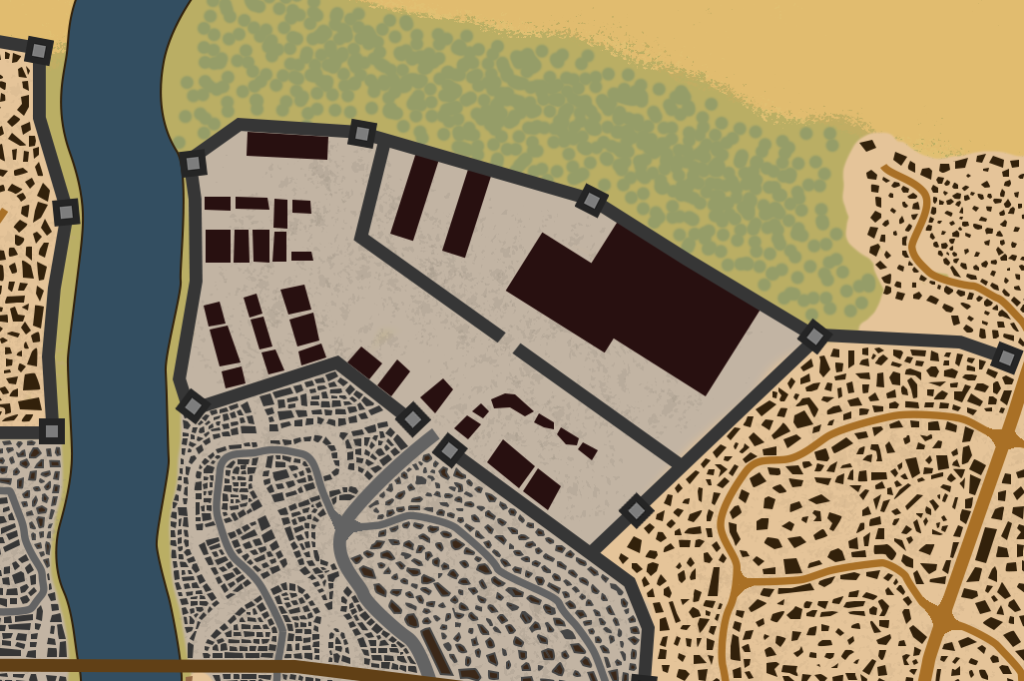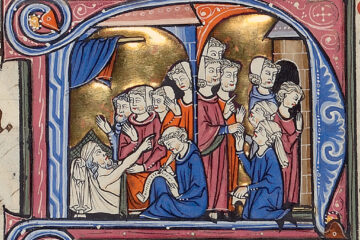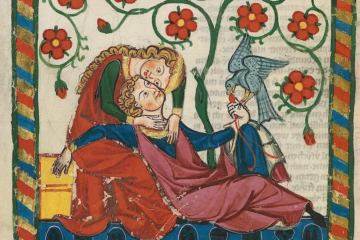City Sights
The Main Square

The Main Square of Rosewood is its main attraction and center of activities. Festivals and celebrations usually take place here, sometimes multiple at a time. At any point, except maybe winter, you can expect to see hundreds of people walking through the Square in order to reach their destination. There is the occasional tree, which offers the bystanders shade during summer months, and there is a large statue of Torrino I Sirius, which depicts him with his left hand on his sword hilt and his right hand outstretched, offering a rose. The statue was built so that it’s pointing in the direction opposite Fernyard.
Perhaps the first thing anyone would notice in the Main Square, would be the elaborate rose motifs etched into the stone tiles on the ground. Not only have they been forever set in stone, but they have been colored red as well, a gift from the Sirius Dynasty to the City of Rosewood. The theft or destruction of these tiles is a crime punishable by a hefty fine. Glory goes to Master Emanuel of Rosewood, who is one of the chief architects of the Restoration.
The Tourney Grounds

Ever since the first Grand Tourney in 1087, the Grand Tournament has become a staple tradition of Rosewood, where contenders from all around come and compete for the title of Grand Champion. Since then, it has been cleared of all obstacles and debris, as well as any peasant home and is exclusively used for staging the the Grand Tourney on the 1st of March, Tournaments all year round, or alternatively, when there are no tournaments, the citizens of Rosewood are free to use the plot of land as a place to train and hone their skills. It is a ground of battle and skill, as many a skilled swordsman stepped foot onto that soil. Torrino II, Argonon var Emril, Charles II, Sir Sesh, Sir Oswald Fisher, and many more trained on those very grounds.
The Guardhouse and the Dungeons

Although not the only Guardhouse in Rosewood to station members of the City Watch, it is their de facto headquarters, given that it is built over the remains of the Imperial Barracks. The Rosewood Guardhouse (pictured left) is the biggest guardhouse in the City, holding nearly 50% of the Watch’s supplies, equipment, and funds within it. As such it is heavily guarded and serves as the office of the Bailiff, the commander of the City Watch. From here, the City Watch handles warrants, arrests, and recruitment and equipment of its members. It is the starting point of all City patrols, as well as the end, with a report made to the Bailiff. The Guardhouse numbers four floors, and is made of stone brick. It has terraces that overlook its surroundings, giving easy visibility onto the streets below.
The City Dungeons (pictured right) are also a repaired Imperial building once used as Barracks for Imperial Officers. Now it serves as the place where prisoners are taken to await trial. By expanding the building with another identical complex right next to it, and adding a subterranean floor, the capacity has been increased to 200, although it rarely ever surpasses 100, likely due to the fact that prisoners are quickly tried, there are multiple holding cells within the various guardhouse across the City and the fact that no one stays in them permanently. For that kind of crime, you would be taken to the Fernyard Dungeons. All of the cells are identical within the City Dungeons. They are stone-tiled, with one barred window to allow sunlight, a chamberpot, and some hay to sleep in. Breakfast is delivered at dawn, and supper at dusk. The meal consists of a small loaf of bread and mashed peas and water to wash it down.
The Bank and the Bathhouse

Rosewood’s Bank (below) is a building constructed during Roman times. It was originally used as an armory for Rosewood’s Auxiliary, however, over time it has taken many roles. Sometime around 1080, it had undertaken the role of a specialized institution. An idea from the Italian merchant cities had come to Rosewood. A building where “bankers” worked. These men and women would grant loans, keep your money safe, and transfer it into other currencies. The Crown approved of this, so the Italian Medici family were invited and founded the Rosewood Bank, and were given explicit permission by the Imperial Crown to mint Buckles. This practice remains to this day. The name Buckle comes from the Imperial Banking Ring given to the Medici family in Rosewood as a show of gratitude from the Emperor. If the ring’s buckle were to be pressed into molten gold, silver, or copper it would produce a Rose imprint, which is used on the backside of official coinage, making them extremely hard to mint.
The Rosewood Bathhouse (above) is situated across from the Bank and sits on the ruins of an old Roman Bathhouse. During the age of the Franks and most of the Imperial Age, the Bathhouse operated as a communal place for bathing in individual wooden tubs, with water heated in the outside, as well as a cold bath in the Bathhouse’s main room which had very little water in and of itself. However, by the time of the Restoration, the Bathhouse was in ruins once more. While nothing distinguished it from the rest of the bathhouses is Rosewood, except its central bath, that would soon change. The masterful Siege Engineer and Philosopher, Jacob Trivillius, put his skills to good use. Together with the knowledge of the University of Rosewood, the help of Master Emanuel, and the funds from the defunct Imperial Army, Jacob was able to restore the Bathhouse to its previous glory. Not just through its looks, but also through restoring its water and heating systems. The river Seyne’s current has been unblocked in order for it to allow passage through a Roman tunnel system into the central bath. Once the water was flowing, Jacob uncovered the technique the Roman’s used to heat the water. A series of furnaces under the bath heat the floor below, increasing the water’s temperature. As such, the Bathhouse is Rosewood’s top timber consumer, requiring monthly shipments in order to function properly. Besides the main bath, the Bathhouse also offers individual baths and other services to its customers. It is owned by the Avigne family of Rosewood.
The Tavern Complex

The Tavern Complex is a special building in Rosewood. It is relatively old, emerging around the year 1100, however, its current shape is a result of the Restoration. The Tavern Complex is a collection of multiple Inns and Taverns all united under one guild of sorts, purchased in 1202 by the Dunwill family. Harold Dunwill is the owner as of 1220 and maintains strict order within his many establishments. The Taverns and Inns all have unique looks, but also share a sense of unity under the Dunwill family name. It is not uncommon for owners of the Inns and Taverns to help each other out during hardships or periods of transition, as the Dunwills are notorious for removing unruly employees from their posts. Not the biggest, but the most popular Tavern is part of a Tavern-Inn combo, called Nan Nicole’s. It’s a Tavern primarily with a rich history, and the only one in the City which can boast to having a King served at its bar.
The Rosewood City Market

The Rosewood City Market is the beating heart of the French Capital. Not only does it offer basic amenities and luxury goods to the people of Rosewood, but to all of the surrounding countryside as well. Moreover, it facilitates trade throughout the continent. Rarely will a merchant traveling the English Channel make their rounds without making a stop at Rosewood. The Highroad connects it to the Italian Merchant States, giving it an endless and priceless influx of exotic materials and valuables which trade hands in the center of the City.
The Market is administered by the City’s Coinmaster in name of the Mayor. The Coinmaster has a host of Market Keepers who assist him in organizing the daily operation of the marketplace, and especially during the monthly market which sees Rosewood’s Market reach its maximum capacity, holding around fifteen thousand people.
It is a specially allotted plot of land that hugs the central banks of the Seyne river. While most of the sales are done on the left side, the workshops are primarily based on the right shore. Here Rosewood prides itself upon its myriads of skilled artisans and craftsmen who hail from all over this City, country, and the world, and have all decided to ply their trade within Rosewood to further serve the King and Kingdom, as well as the City.
Many traders arrive from land, but the Seyne offers great mobility for seafaring merchants who peddle their goods while crossing rivers. There are ample docks for the docking of smaller vessels, simple trading ships. As Rosewood has no naval defense during peacetime, this has made the enforcement of contraband laws significantly harder. Smugglers enjoy a haven thanks to the size of the Seyne and regularly smuggle illegal items into the City, and even people.
The Archdiocese of Rosewood

The Archdiocese (all white buildings) are part of the Archbishop’s direct jurisdiction. This diocese, along with the living quarters for its members, includes the Cathedral (largest building), the Imperial Library (furthest left), the Rosewood Infirmary (furthest right), and the University of Rosewood (bellow).
The Cathedral
The Rosewood Cathedral, or the Cathedral of St. Leena, is the largest Cathedral in all of France. Its construction began in 1080 and was finished in its entirety in 1208, although the Cathedral operated since 1105. Its outside was damaged during the Fall of Rosewood in 1168, however, once the City fell, the Holy Roman Emperor ordered any man who stole from it be executed. The Cathedral thus retained its wealth, and it was the place where the victorious Germans prayed after their victory over the French of Rosewood. The entrance is decorated with various motifs, both Biblical and historical.
It boasts a capacity of 8.000 and two large bell towers which overlook the entire City. The Bells are named Adam and Eve. While the nave cannot hold nearly as many as 8000 people, it is still one of the largest in the world. Lining the sides of the nave are the tombs of the previous rulers of the Empire and the Kingdom. Besides the plethora of rooms it uses to house its priests and other servants, the Cathedral has its own granaries, garden, baths, stables, kitchens, a nunnery, a monastery, an orphanage, and is the only Cathedral in the world to have a Pope’s office. During the reign of Pope Alexander I, he often made residence in Rosewood, and it became his permanent home. In 1085 a room within the Church was declared the sole property of the Bishop of Rome. The nave is beautifully decorated both by the stonemasonry of Rosewood’s greatest masters and by the cathedral glasswork depicting various scenes from the Bible, hand-blown by the best glass smiths of Venice, and Constantinople.
Finally, Rosewood’s Cathedral is a place of wonder for most pilgrims across Europe, because it boasts the ownership of three Holy Relics, the fingerbones of St. Leena, the Holy Grail, as well as the Holy Lance, the latter being disputed. Nevertheless, it offers pilgrims a sight to behold and a reason to visit the Cathedral.
The Library
The Imperial Library of Rosewood is the crown jewel of the City. It houses thousands of books, all transcribed by the scribes at the Cathedral. In addition to keeping transcribed and translated historical and political texts, the Imperial Library also cooperates with the University, offering the Masters to write within Rosewood’s prized possession, the Rosewood Codex, as well as preserve any historical text they author.
The Rosewood Codex is protected in the Library and represents written accounts of Rosewood’s monthly happenings since the year 1180; arrests, trials, executions, marriages, divorces, births, deaths, tournaments, events, etc. It is accessible only by the Masters of History, who work daily to log every detail of Rosewood’s history. The book is written in Latin, and cannot be viewed by anyone except the Baron, Mayor, King, Archbishop, Pope, or the Masters of the University.
The Library is two-storied but is wide enough to hold an impossible selection of books and scripts. It was a gift from Emperor Torrino I to Pope Alexander I, therefore all workers at the Library enjoy the protections of the Church.
The Infirmary
The Rosewood Infirmary is home to the City’s Medici (not to be confused with the Medici banking family), the Church-trained physicians of Rosewood who call themselves ‘Leeches’, likely due to their use of leeches during draining. Despite the fact that the Infirmary rarely used bloodletting anymore. The Four Humor Theory is accepted by the infirmary, however, they consider it a last resort. Instead, they use self-authored texts on medicine, with knowledge borrowed from personal experience, Greek theorems, and Arab pilgrims. Rosewood has become a beacon of medicinal progress, decades ahead of its neighbors.
The Infirmary can hold up to 500 sick people and assist women during childbirth. It offers all of its services for free to the people of Rosewood and is funded directly by the Church tithes of the City and its surrounding area.
The University
The Rosewood University or the University of Wilhelm the Great is home to the scholars of the Kingdom of France. As the central hub for all knowledge, it is immensely important to the progress of the country. During their studies, Students are given the protection of the Church, as well as Masters who teach. Once their study is complete, Masters can expect to be employed in noble courts as advisors. They come at a high price but offer valuable insight and priceless advice to their patrons. Rich nobles might also send their sons to study and prepare them for governance. It is not exclusively male, but women are rarely allowed to go by their fathers who often opt out of funding their studies. Rich women enjoy the knowledge of the University. It is also not uncommon for Masters to become Voices for their liege. The institution has opened up many opportunities for the rich and the pious within France, and beyond since widely recognized Masters can be sent as diplomats or even gifts to foreign courts.
Fernyard Fortress

The King’s Castle and residence is called Fernyard Fortress and consists of the main building and the bailey area. Architecturally, Fernyard has been upgraded and rebuilt since the time of the Romans, as it is the oldest fortification there, built over the ruins of a Roman manor. Today it towers over the rest of Rosewood and provides a magnificent sight of the cityscape from atop Thornhill.
The castle boasts a great hall that serves as both the throne room and feast hall, allowing the King to maintain his court. The great hall is situated right at the entrance of the main building and has stairs which lead into the west and east wing, and the other floors, while the back of the throne room leads into the gardens and the King’s Chambers. Beside the Fernyard Gardens, not too far from the King’s Chambers, there is a veranda which overlooks the Main Square, and thanks to the ingenuity of the Masters in his service, the King has the ability to throw his voice onto the crowd below. The acoustics were precisely crafted to allow any man or woman in the Main Square to hear the King’s voice once he spoke downwards, or began shouting. The upper floors are chambers reserved for Rosewood’s nobles, and visiting diplomats and courtiers.
The Mayor’s Palace

Where once Headow Keep, the ancestral home of the Armingtons, stood, now stands the Mayorly Palace and overlooks the entirety of Rosewood from atop Hauthill. It now serves as the Mayor’s place of residence from which they administer the city, handle requests, hear common troubles, and resolve disputes. Once elected by the College of Rosewood, the Mayor serves for life or until removed. The office of Mayor is a difficult, but powerful one. Since the City is under the direct vassalage of the King, the Mayor answers to no higher authority but himself. Unless he starts an uprising or noble feud, the Mayor is given free rein to rule the City as he sees fit. True, he can be removed by the College, but that has not happened since the college was founded, in its original form as the Council, back in 1089.
The Palace offers luxurious living quarters for the Mayor, his court, and his guests. Upon entry, one is greeted by the Cabinet, where the Mayor deals with his daily duties. Ratifying and noting trials, listening to the people of Rosewood, meeting with his small council. Besides that, the only room of note is the Mayor’s chambers, complete with a terrace overlooking Rosewood.
Fort Fisher

The newest castle in Rosewood. Its construction began in 1176 and continues even in 1220. Despite this, the Fort houses the main Fisher House Branch and oversees the Fisher farmlands to the north of Rosewood, as well as the woods on the other side of the Outer Walls, which are the property of the Baron of Fort Fisher.
In addition to housing many Fishers within its walls, the Fort also hosts their courts and guests. They are a powerful political faction within the City and the most powerful family within Rosewood, along with the Medici, Avigne, Dunwills, Midas, Emrils, and other lesser houses.
It has no particular architectural marvels and serves its function as Rosewood’s third defensive structure, something it obviously lacked during the Fifty Years’ War.


